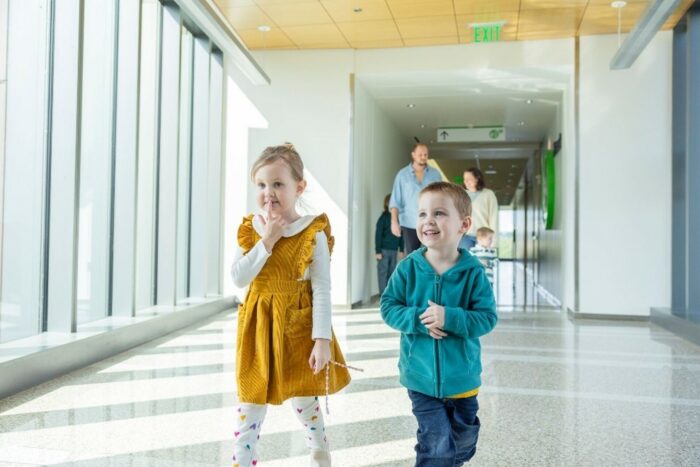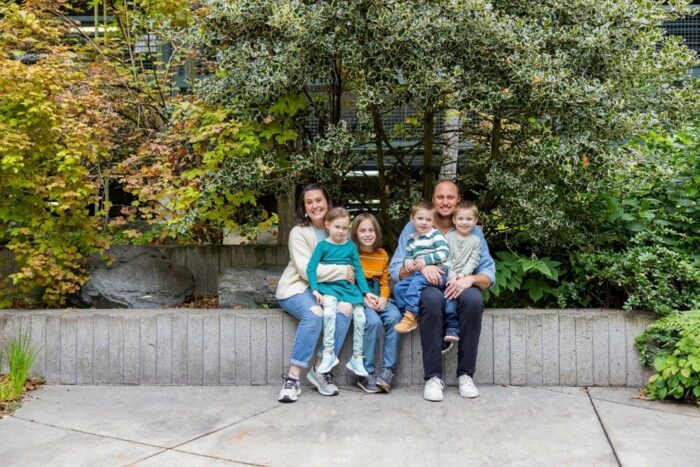 In 2019, Samantha and Kyle Hatch received wonderful news: Samantha was pregnant with identical twins.
In 2019, Samantha and Kyle Hatch received wonderful news: Samantha was pregnant with identical twins.
The couple already had two kids, Ben and Penny, and envisioned all of the roughhousing, road trips and happy mayhem that comes with four children.
But everything changed when a routine ultrasound showed that one of the twins, William, had Hypoplastic Left Heart Syndrome (HLHS), a severe congenital condition in which the left side of the heart is underdeveloped.
To survive, he would need to undergo open-heart surgery shortly after birth, followed by two more heart surgeries in short order. Even then, there would be only a 50% to 60% chance of William reaching age 5.
A second diagnosis
In May 2020, as COVID-19 was bringing the world to a halt, twins William and Theo were born. Within days, William had his first open-heart surgery at Seattle Children’s. Thirteen weeks later, he returned home to reunite with his twin and meet his extended family for the first time.
After just one night, however, William began having difficulty breathing. He was readmitted to Seattle Children’s where he recovered and awaited his second open-heart surgery.
Around the same time, Samantha and Kyle noticed 18-month-old Penny was having difficulty walking. An MRI revealed a mass the size of a strawberry at the base of her spine.
The Hatches learned their daughter likely had neuroblastoma, a solid-tumor cancer with a typical survival rate of about 50%. “We felt fear and rage; I started to think I was cursed,” Kyle says.
To make matters worse, the biopsy caused her tumor to swell and press against the nerves in her spinal cord, paralyzing her right leg.
“It was a huge challenge for them to go through,” says Dr. Danielle Kirkey, Penny’s fellow oncologist. “To have an acute change in their daughter’s mobility and then to receive a diagnosis that turned their life upside down, it was a lot to process.”
The surgical team decided to operate that day to remove as much of the tumor as they could. In the months ahead, Penny would need chemotherapy, radiation, a stem cell transplant, and immunotherapy.
Wrapping care around families
COVID-19 restrictions made it impossible for extended family members to visit the hospital to lend support — which was difficult enough during William’s heart surgery. Now the family faced further isolation and the stress of having a second child in the hospital for surgery and chemotherapy.
Given this extreme situation, Seattle Children’s care team mobilized and prioritized the Hatches’ comfort. Although patients receiving cancer and heart care are usually located in different areas of the hospital, William and Penny were brought together into the same room.
“It was a really special moment,” Samantha recalls.
Though the Hatches were unable to receive visits from friends or relatives, they soon realized a new kind of family was forming around them at Seattle Children’s. A friendship blossomed between Samantha and Maria, an Environmental Services team member.
“She would always come and say hi to Penny and visit with me,” Samantha says. “She even gifted Penny a little doll, which was so kind.”
On another occasion when William wouldn’t stop crying, a nurse named Erin stepped up.
“She stayed by our side and just patted William for hours,” Samantha says. “So many people had a hand in helping us get through.”
When Samantha and Kyle faced mounting expenses as they traveled back and forth between hospitals and home, team members also offered gas cards, meal vouchers, extra food and a breast pump for nursing.

Donors provide critical support
In a health crisis, parents are consumed by one thing — their child’s recovery. Financial matters can be an afterthought, and a stress families aren’t prepared for.
“You can see how families get so ripped apart,” says Samantha. “But the programs at Seattle Children’s, and the donors who fund them, make all the difference in giving families like ours some sort of normalcy.”
For families who face financial burdens related to their child’s care, the donor-driven Uncompensated Care Fund brings tremendous relief and allows the financial assistance program at Seattle Children’s to be generous and easy to access—so patient families can stay focused on their child’s health, regardless of their ability to pay.
Last year alone, Seattle Children’s provided a record $282 million in uncompensated care — including $21 million covered by generous donors — to meet our founding promise to care for all children who need us.
That kind of generosity is never forgotten; in fact, many families who receive uncompensated care later return to Seattle Children’s as donors, helping the next generation of families in need.
On the road to recovery
Today, William is an active 3-year-old toddler whose critical open-heart surgeries are behind him — his chance for long-term survival is now about 90%.
Penny, now 5 years old, is in remission and recovering from paralysis of her right leg. She is walking with increased mobility but may continue to need care throughout her life.
At home with her four children, Samantha recounts a road trip the family took over the summer in their camper van — while simultaneously helping William and Theo negotiate who gets to hold a coveted whale cup.
“We spent so much time in the hospital during those crucial childhood years,” she says. “It was time to make some fun memories.”

